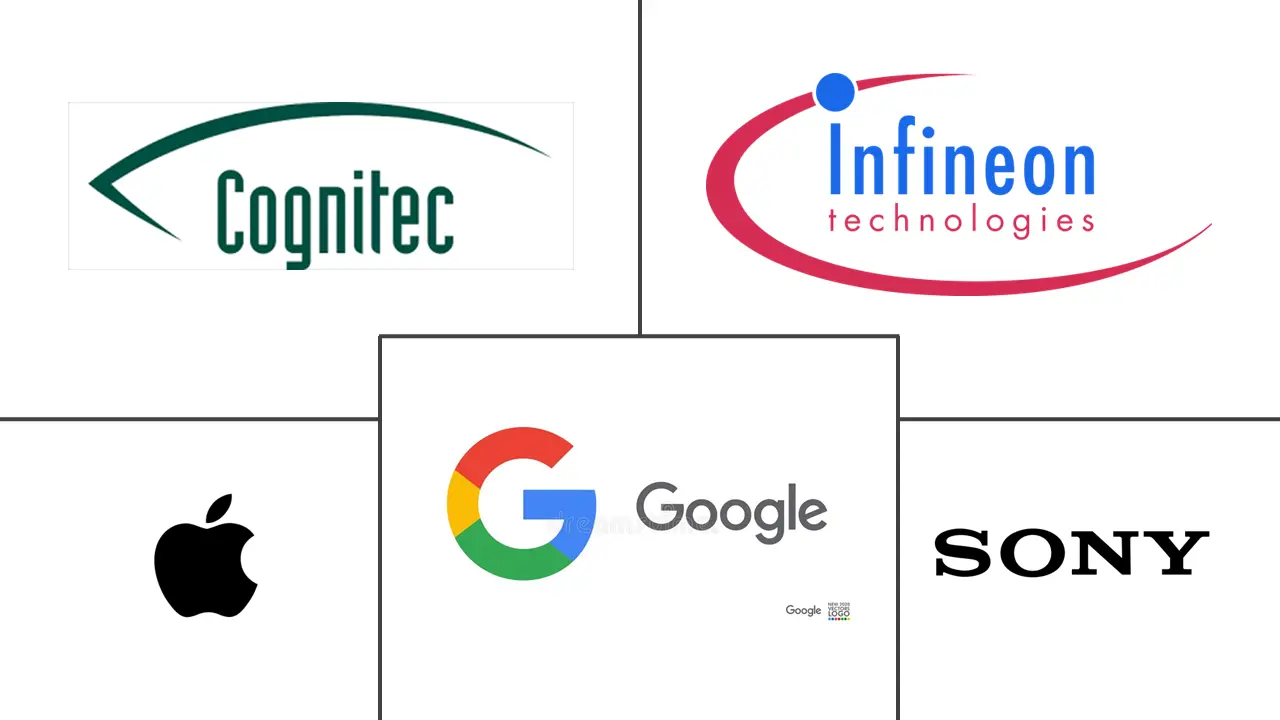Gesture Recognition In Retail Market Size and Share
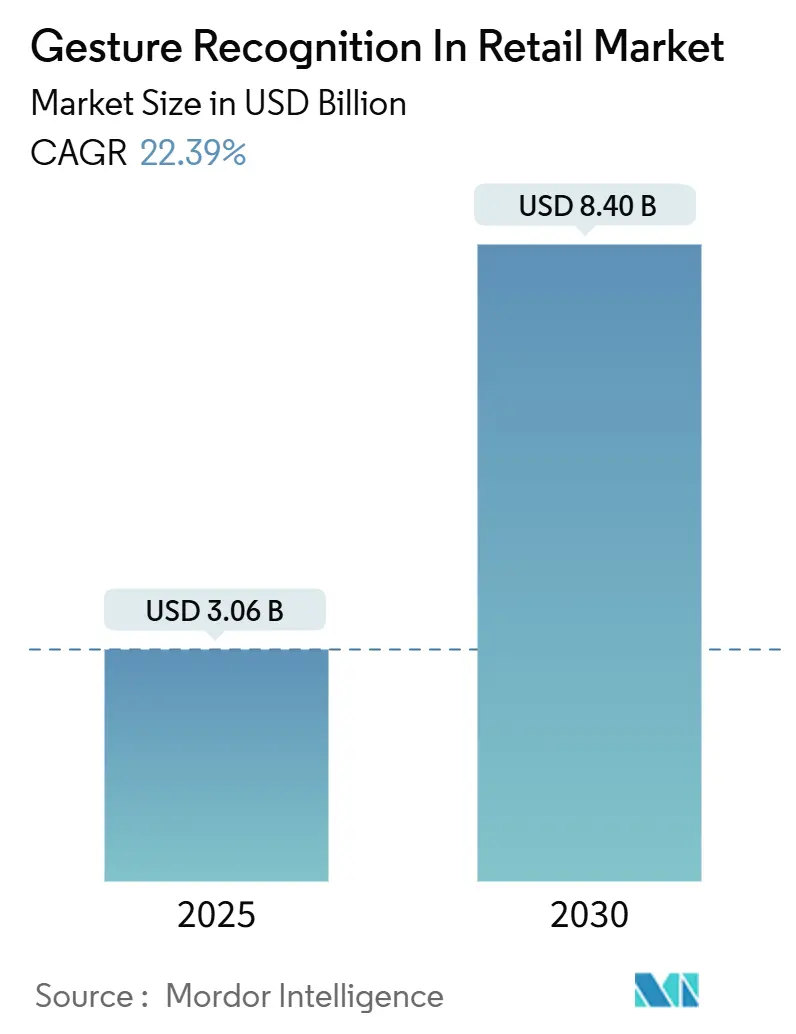
Gesture Recognition In Retail Market Analysis by Mordor Intelligence
The Gesture Recognition In Retail Market size is estimated at USD 3.06 billion in 2025, and is expected to reach USD 8.40 billion by 2030, at a CAGR of 22.39% during the forecast period (2025-2030).
Rising labor shortages, sustained demand for contact-free journeys, and the pairing of edge AI with millimeter-wave radar now allow through-shelf gesture detection that works without a direct camera view[1]Intel Corporation, “Edge AI Vision Accelerates Retail Innovation,” intel.com. Retailers gain richer in-aisle analytics, while consumer packaged goods brands monetize the resulting behavioral data streams. Hardware costs continue to fall as 3-D sensing and AI chipsets integrate into mainstream point-of-sale devices. Regulatory clarity in major markets and maturing privacy-preserving architectures further de-risk large-scale roll-outs. Collectively, these dynamics support sustained double-digit expansion for the gesture recognition in retail market through the decade.
Key Report Takeaways
- By technology, touch-based systems held 78.1% of gesture recognition in retail market share in 2024, whereas touch-less platforms are projected to expand at a 24.1% CAGR to 2030.
- By interaction mode, hand and finger gestures accounted for 66.8% share of the gesture recognition in retail market size in 2024; full-body recognition is poised for 23.4% CAGR growth through 2030.
- By function, checkout and point-of-sale solutions commanded 71.4% of the gesture recognition in retail market size in 2024, while customer engagement displays are advancing at 23.7% CAGR.
- By retail format, supermarkets and hypermarkets led with 62.3% revenue share in 2024; apparel and department stores register the fastest 23.0% CAGR to 2030.
- By geography, North America captured 36.5% of gesture recognition in retail market share in 2024, whereas Asia-Pacific registers the highest 22.8% CAGR through 2030.
Global Gesture Recognition In Retail Market Trends and Insights
Drivers Impact Analysis
| Driver | (~) % Impact on CAGR Forecast | Geographic Relevance | Impact Timeline |
|---|---|---|---|
| Rising demand for contact-free shopping | +4.2% | Global, strongest in North America and Europe | Short term (≤ 2 years) |
| 3-D sensing and AI chips in retail devices | +3.8% | Core in Asia-Pacific, spill-over to North America & Europe | Medium term (2-4 years) |
| Smart-retail and autonomous-store expansion | +3.5% | Global, early in China, Japan, Germany | Medium term (2-4 years) |
| mm-wave & UWB radar for through-shelf use | +2.9% | North America and EU, expanding to Asia-Pacific | Long term (≥ 4 years) |
| In-aisle gesture analytics monetization | +2.1% | Developed markets | Medium term (2-4 years) |
| AR smart-glasses integration | +1.8% | North America & Europe, pilot projects in Asia-Pacific | Long term (≥ 4 years) |
| Source: Mordor Intelligence | |||
Rising Demand for Contact-Free Shopping Experiences
Pandemic-era behaviors solidified consumer expectations for touchless journeys, and major European grocers have validated full-scale computer-vision supermarkets exceeding 1,000 m² footprints. Retailers report measurable reductions in average checkout time and greater customer throughput, translating into higher basket sizes and repeat visits. Competitive pressure now pushes even mid-tier chains to evaluate gesture-enabled front-end redesigns. As more operators deploy privacy-preserving edge architectures, adoption accelerates without added cloud fees. These developments reinforce the near-term growth outlook for the gesture recognition in retail market.
Increasing Penetration of 3-D Sensing and AI Chips in Retail Devices
Edge silicon now executes real-time gesture inference locally, removing bandwidth constraints and cutting latency[2]Synaptics Inc., “Astra AI-Native Platform Overview,” synaptics.com. Recent prototypes pairing 3-D depth sensors with dedicated machine-learning cores showed 99.8% gesture accuracy across 18 classes, even under variable lighting. Asian OEMs leverage scale manufacturing to push unit prices below USD 20, opening access for regional grocers and convenience stores. Lower cost of ownership and ease of retrofitting existing lanes help broaden the reachable base of the gesture recognition in retail market. Joint reference designs from chip suppliers and solution integrators also reduce integration effort for retailers with limited in-house engineering talent.
Expansion of Smart-Retail and Autonomous-Store Formats
Chinese, Japanese, and European pilots have transitioned into multi-store chains that rely on gesture recognition for frictionless entry, product identification, and exit-based payment. Operators cite labor savings exceeding 30% and shrinkage reduction through real-time anomaly alerts. Brand owners participate by sponsoring interactive end-caps that respond to consumer gestures, generating incremental advertising revenue. As capex norms converge with those of traditional self-checkout lanes, autonomous formats become commercially viable for community supermarkets and travel-retail outlets, further expanding the gesture recognition in retail market footprint.
Advancements in mm-wave and UWB Radar Enabling Through-Shelf Gestures
Millimeter-wave radar now tracks hand movement through standard shelving with 95.2% precision while preserving customer anonymity because only motion point clouds are processed. The addition of ultra-wideband ranging enables directional pointing and spatial anchoring, allowing shoppers to pull product data onto nearby displays without touching screens. Technology vendors seek patents covering radar-based interaction for premium retail fixtures, hinting at forthcoming flagship deployments. These breakthroughs unlock new zones inside aisles where optical cameras are blocked, enlarging the serviceable area of the gesture recognition in retail market.
Restraints Impact Analysis
| Restraint | (~) % Impact on CAGR Forecast | Geographic Relevance | Impact Timeline |
|---|---|---|---|
| Algorithmic complexity in live stores | -2.8% | Global, highest in demographically diverse markets | Short term (≤ 2 years) |
| Privacy and regulatory push-back | -2.1% | Europe & North America, spreading worldwide | Medium term (2-4 years) |
| Edge-network latency at busy checkouts | -1.6% | Global, acute where connectivity is limited | Short term (≤ 2 years) |
| Electromagnetic interference from dense IoT | -1.2% | North America & Europe, extending to Asia-Pacific metros | Medium term (2-4 years) |
| Source: Mordor Intelligence | |||
Algorithmic Complexity and Accuracy Variance in Live-Store Environments
Retail settings introduce occlusions, reflective surfaces, and crowd density that cut gesture accuracy when compared with lab results, particularly for customers carrying bags or wearing gloves. Bias across age groups and body mobility still appears in computer-vision models, raising inclusion concerns. Continuous re-training regimes and larger annotated data sets drive deployment cost upward. Merchants must tune sensor layouts per store to preserve acceptable performance, complicating multi-format roll-outs. Until middleware platforms abstract this complexity, some chains remain cautious, tempering the short-term expansion of the gesture recognition in retail market.
Privacy and Regulatory Push-Back on Continuous Vision Tracking
Europe’s AI Act bans emotion inference in workplaces, directly affecting camera-based analytics that track dwell time or facial expression. United States state-level biometric statutes add consent requirements and introduce significant statutory penalties. Retailers therefore shift toward on-device processing and federated-learning architectures that avoid raw image transmission. Implementation of these safeguards raises capex by double-digit percentages and may delay procurement cycles, dampening near-term growth for the gesture recognition in retail market.
Segment Analysis
By Technology: Touch-less Innovation Accelerates Despite Touch-Based Dominance
Touch-based platforms represented 78.1% of gesture recognition in retail market share in 2024 as retailers favored proven systems bolted onto legacy lanes. Even so, the touch-less segment is set to record a 24.1% CAGR through 2030, underscoring a shift toward hygienic and seamlessly integrated store journeys. Pilots by big-box clubs that clear members via camera recognition at exits illustrate how touch-less can replace manual receipt checks. Hardware vendors now integrate radar sensors alongside RGB-D cameras, trimming bill-of-materials and closing the precision gap that once favored touch-based panels. As deployment confidence rises, the gesture recognition in retail market size tied to touch-less offerings is projected to exceed USD 3 billion by 2030, doubling its 2024 base.
Retailers increasingly view touch-less gesture recognition as a brand differentiator that elevates experience, especially in high-margin segments such as luxury fashion and consumer electronics showrooms. Meanwhile, touch-based platforms remain relevant for use cases that demand pinpoint accuracy, such as signature capture or build-to-order kiosks. Those dual pathways indicate a coexistence model rather than outright substitution, allowing suppliers to position modular solutions that scale with client needs. Continued iterations of neural processing units will likely lower latency to sub-30 milliseconds, preserving intuitive interactions and encouraging further penetration of the gesture recognition in retail market.
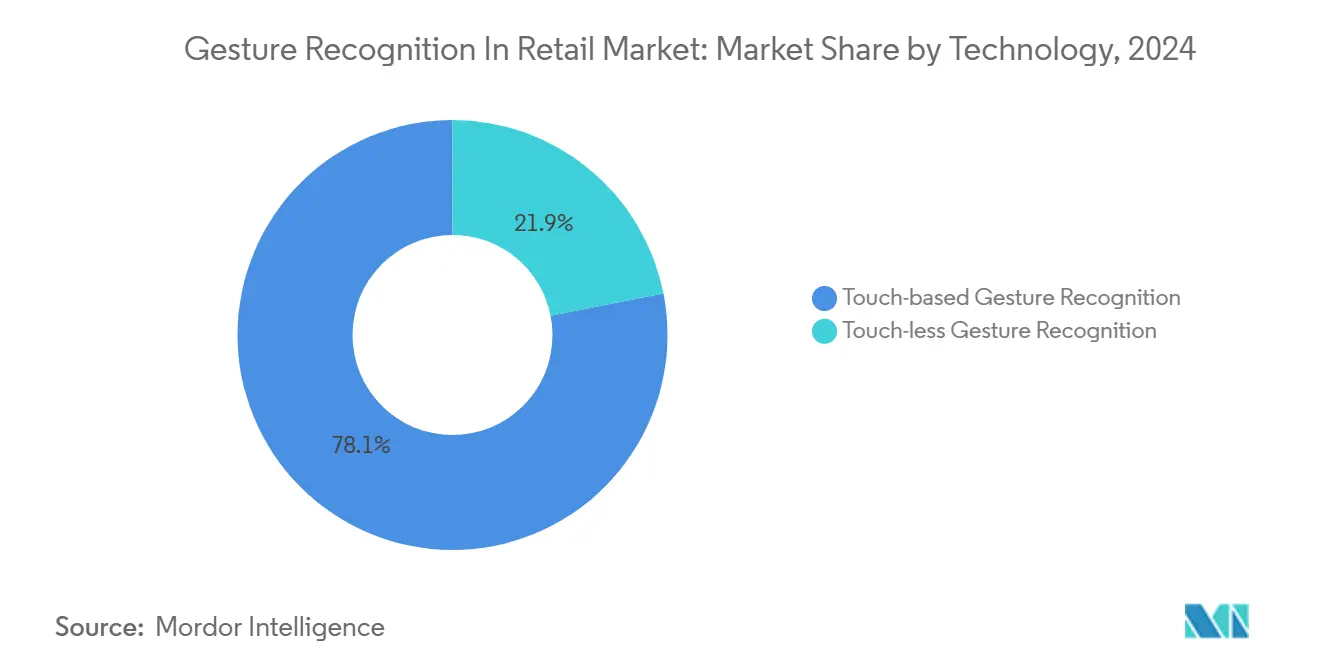
Note: Segment shares of all individual segments available upon report purchase
By Interaction Mode: Full-Body Recognition Emerges as Growth Engine
Hand and finger inputs dominated, accounting for 66.8% of the gesture recognition in retail market size in 2024, thanks to consumers already conditioned by smartphones. Full-body systems, however, register a 23.4% CAGR to 2030 as faster GPUs in edge boxes decode skeletal movement for immersive display walls and aisle-level analytics. Head-centric micro-gestures found early adoption in convenience stores and petrol marts where hands are busy handling goods. Research prototypes combining voice and gesture score higher for intent accuracy, implying a multimodal trajectory for the gesture recognition in retail market.
Wearable bands that pick up neural or muscle signals bring an additional interaction layer for differently abled shoppers, broadening accessibility. Retailers use full-body heat maps to pinpoint hotspots and redesign aisles, demonstrating that gesture data can unlock operations value beyond front-end checkout. The expanding use-case set underscores why the gesture recognition in retail industry continues to invest in advanced pose estimation algorithms despite the higher compute requirement.
By Function: Customer Engagement Displays Drive Innovation Beyond Checkout
Checkout solutions retained 71.4% share of the gesture recognition in retail market size in 2024 because the ROI from faster transactions and reduced staffing resonates universally. Yet interactive engagement displays advance at 23.7% CAGR as merchants discover revenue per square foot lifts when shoppers receive personalized offers triggered by gestures[3]Intel Corporation, “Edge AI Vision Accelerates Retail Innovation,” intel.com. Hands-free inventory screens in back-of-house settings streamline cycle counts, a boon for foodservice and pharmacy formats where hygiene rules restrict touch.
Marketing departments now own budgets for in-aisle kiosks that recommend related products when a shopper pauses. Analytics generated from these encounters feeds into dynamic planogram revisions, tightening replenishment cycles. By moving beyond payment, the gesture recognition in retail market taps budget pools previously unavailable to point-of-sale vendors, diversifying revenue streams across the retail organization.
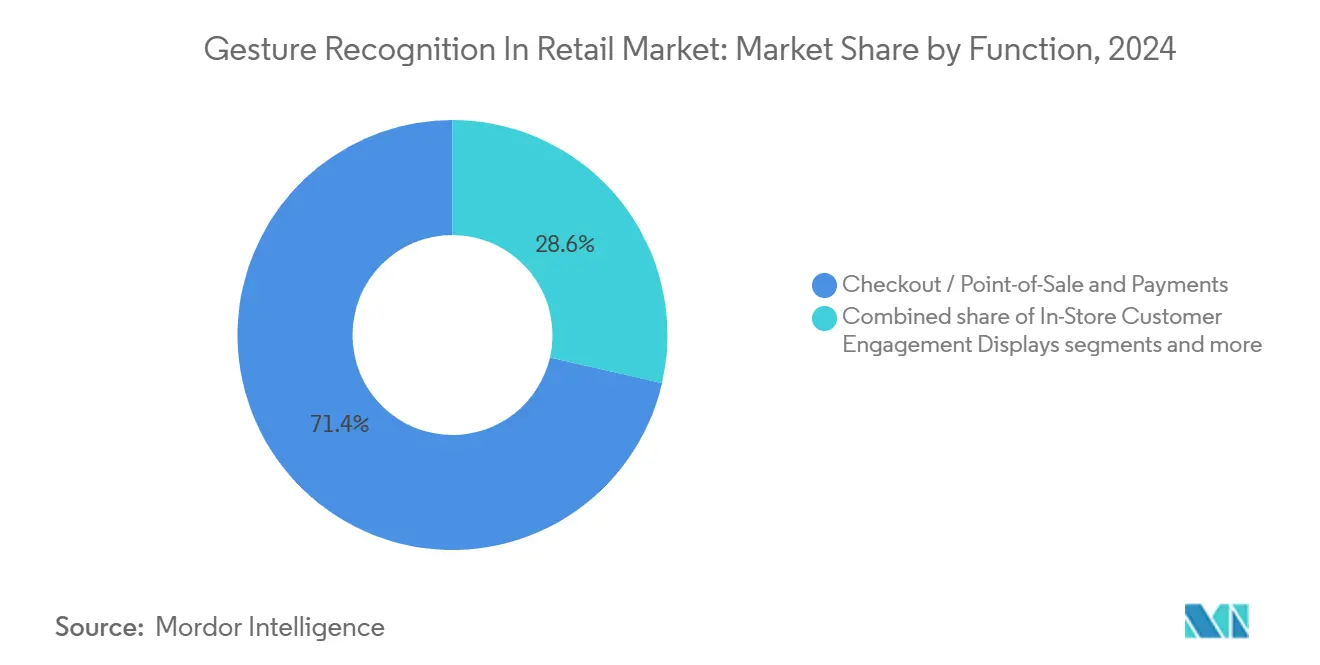
Note: Segment shares of all individual segments available upon report purchase
By Retail Format: Department Stores Lead Digital Transformation
Supermarkets and hypermarkets captured 62.3% of 2024 revenue due to wide-area autonomous checkout deployments, but growth moderates as penetration levels approach a plateau in developed economies. Department and apparel stores log the fastest 23.0% CAGR to 2030, propelled by virtual try-on mirrors and gesture-controlled thematic windows that fuse online and in-store brand storytelling. Convenience players exploit unmanned micro-store blueprints for transport hubs where 24-hour availability outweighs capex.
Luxury boutiques deploy gesture-guided product journeys that replace staffed counters, freeing associates for high-value consultations. Specialty jewelers integrate controlled gestures for secure cabinet access, enhancing both experience and shrink mitigation. These varied roll-outs illustrate how widening retail format coverage underpins sustained expansion of the gesture recognition in retail market.
Geography Analysis
North America, with 36.5% share of the gesture recognition in retail market size in 2024, benefits from early adopter big-box chains and a comparatively permissive biometric regime. Federal guidelines remain less restrictive than Europe’s, enabling chain-wide pilots that rapidly scale when ROI is proven. Over 500 grocery sites now run camera-only exit checkout, reinforcing the region’s leadership.
Asia-Pacific posts the highest 22.8% CAGR through 2030 as Chinese payment ecosystems and Japanese unmanned formats integrate gesture recognition into end-to-end store automation. Government retail-digitization grants lower upfront cost barriers, while consumers show strong acceptance of biometric processes. Local hardware manufacturing density shortens supply chains and accelerates iteration cycles, further catalyzing uptake.
Europe follows with privacy-compliant architectures that blend edge processing and encrypted cloud synchronization to satisfy the EU AI Act. Multinational grocers test gesture-enabled mega-stores across Germany, France, and the Nordics, providing blueprints for pan-EU roll-outs. Emerging regions in Latin America and the Middle East start from smaller bases but see double-digit adoption as global vendors introduce turnkey packages targeted at mid-sized supermarket groups. This cascade effect supports a geographically diversified enlargement of the gesture recognition in retail market.
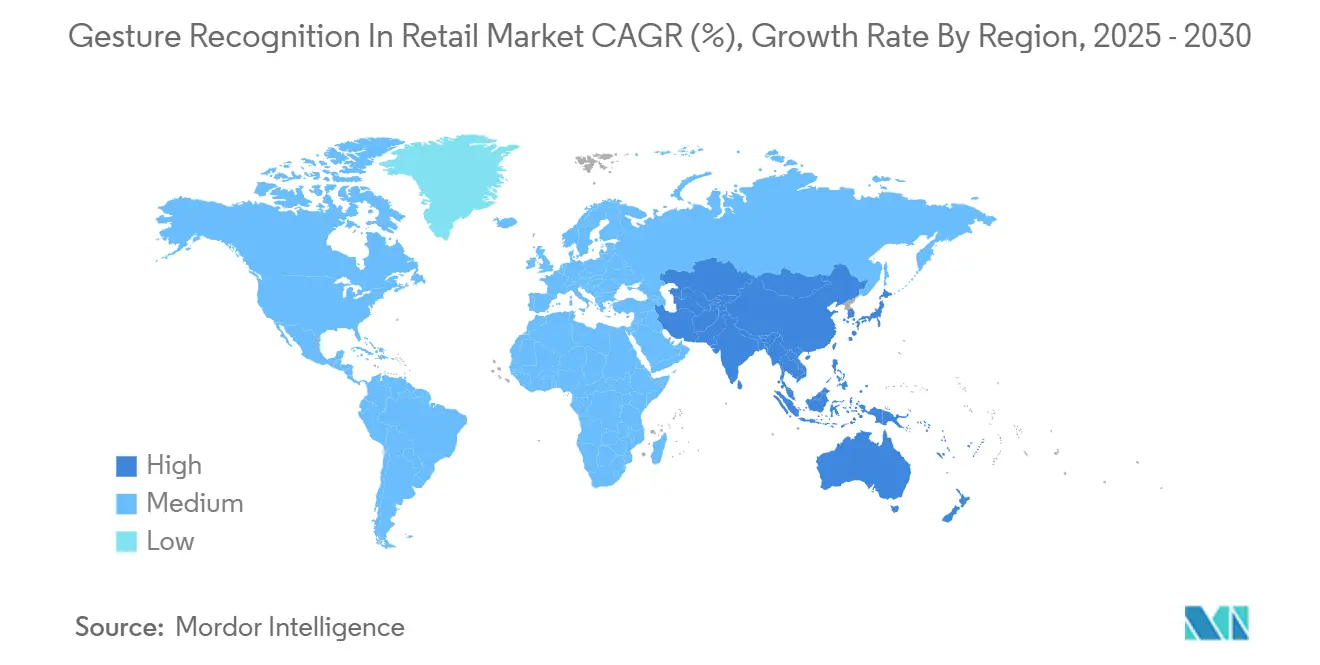
Competitive Landscape
The gesture recognition in retail market features moderate fragmentation. Technology majors such as Apple, Google, Microsoft, and Intel combine vast research and development spend with integrated hardware-software stacks. These incumbents leverage patent portfolios to secure platform stickiness, for instance Google’s electrical-impedance hand reconstruction patent that could embed gesture input into everyday devices.
Specialist challengers fill niche gaps: Veesion applies skeletal analysis to real-time loss-prevention use cases and recently raised EUR 53 million (USD 61.01 million) to speed global expansion. PreAct’s acquisition of Gestoos fused flash LiDAR with gesture models, sharpening object-level recognition for shelf interactions. Cross-industry alliances grow as retailers demand turnkey bundles; Synaptics’ USD 198 million grab of a Broadcom wireless unit bolsters edge connectivity that underpins gesture data back-haul.
Price pressure intensifies at the mid-market where commoditized sensors meet open-source inference engines. Vendors differentiate via compliance toolkits that audit datasets and enable federated retraining to satisfy privacy statutes. White-label platforms are gaining ground among regional system integrators who localize user interfaces and language models, thereby expanding the overall gesture recognition in retail market addressable base.
Gesture Recognition In Retail Industry Leaders
-
Apple Inc.
-
Cognitec Systems GmbH
-
Google LLC
-
Infineon Technologies AG
-
Sony Corporation
- *Disclaimer: Major Players sorted in no particular order
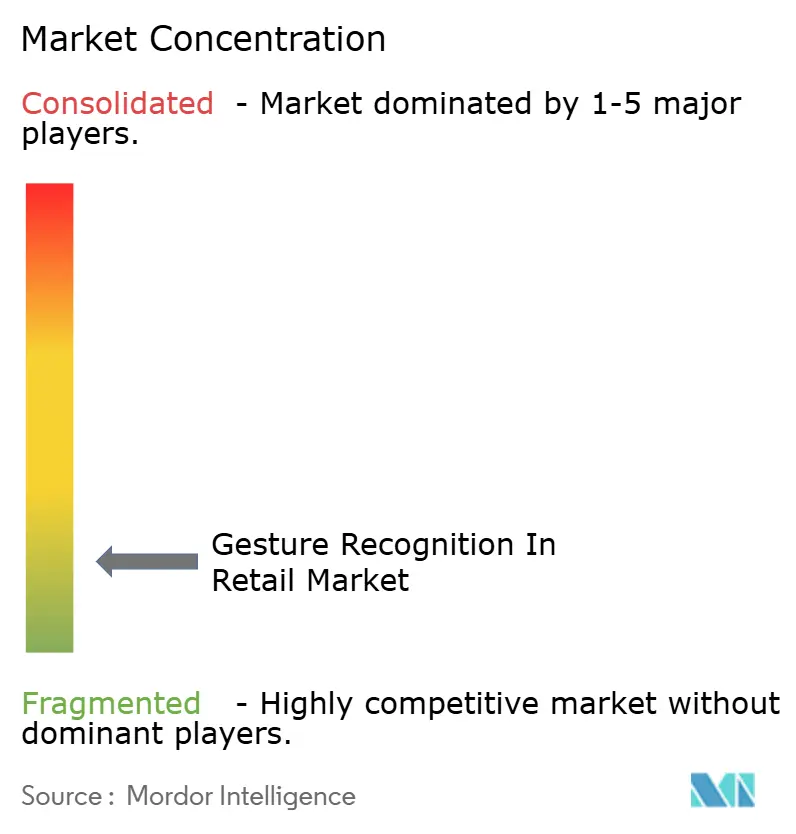
Recent Industry Developments
- June 2025: FairPrice Group launched “Store of Tomorrow” with Google Cloud to roll out smart carts featuring AI-guided navigation and gesture-driven recommendations.
- May 2025: Veesion secured EUR 53 million (USD 61.01 million) to advance gesture-based shoplifting prevention analytics.
- May 2025: AVITA and Fainders.AI began Japan-Korea collaboration on avatar-assisted unmanned stores leveraging vision AI for gesture interaction.
- March 2025: Kende Retail Operation and Coca-Cola HBC opened Hungary’s first autonomous convenience store using computer-vision cart tracking.
Research Methodology Framework and Report Scope
Market Definitions and Key Coverage
Our study defines the gesture recognition in retail market as every hardware component, embedded firmware, middleware layer, and application software that lets shoppers or store staff operate on-premise displays, kiosks, shelves, or checkout points through interpreted hand, finger, body, or facial gestures inside physical retail formats worldwide.
Scope Exclusions: Solutions built solely for pure-play e-commerce, warehouse robotics, or consumer electronics intended for home use are not included.
Segmentation Overview
- By Technology
- Touch-based Gesture Recognition
- Touch-less Gesture Recognition
- By Interaction Mode
- Hand and Finger Gestures
- Head / Nod Gestures
- Full-Body Gestures
- Multimodal (Gesture and Voice)
- By Function
- In-Store Customer Engagement Displays
- Checkout / Point-of-Sale and Payments
- Store Operations, Inventory and Analytics
- By Retail Format
- Supermarkets and Hypermarkets
- Convenience Stores
- Apparel and Department Stores
- Specialty Retailers
- Geography
- North America
- United States
- Canada
- Mexico
- Europe
- Germany
- United Kingdom
- France
- Italy
- Spain
- Rest of Europe
- Asia-Pacific
- China
- Japan
- India
- South Korea
- Australia
- Rest of Asia-Pacific
- South America
- Brazil
- Argentina
- Rest of South America
- Middle East and Africa
- Middle East
- Saudi Arabia
- United Arab Emirates
- Turkey
- Rest of Middle East
- Africa
- South Africa
- Egypt
- Nigeria
- Rest of Africa
- Middle East
- North America
Detailed Research Methodology and Data Validation
Primary Research
Our analysts interviewed sensor OEM engineers, retail IT integrators, procurement heads from supermarkets, and APAC mall operators, then ran follow-up surveys across North America, Europe, and key Asian economies. These conversations validated uptake triggers, price erosion rates, and the typical retrofit footprint that secondary material only hinted at.
Desk Research
We combed public data streams such as the US Census Bureau's Monthly Retail Indicators, Eurostat Structural Business Statistics, UN Comtrade export codes 9031 and 8471, National Retail Federation briefs, IEEE Xplore conference papers, and patents lodged with the USPTO. Trend articles and investor decks from leading sensor makers guided baseline cost movements.
To profile retailers' adoption cadence, we drew on press releases, tender portals, and pilot deployment news archived within Dow Jones Factiva and verified the financial health of listed and private chains through D&B Hoovers. The sources cited above illustrate the breadth of evidence; many other publications, databases, and trade bulletins were also tapped during desk work.
Market-Sizing & Forecasting
We began with a top-down build that reconstructed the global installed base of interactive retail touchpoints from retail floor space and self-checkout penetration, overlaying gesture-ready retrofit ratios. Select bottom-up checks, vendor shipment roll-ups and sampled average selling prices, grounded the totals. Inputs fed into a multivariate regression that links interactive kiosk shipments, sensor ASPs, footfall conversion ratios, retail technology capex, and regional GDP per capita. Where supplier splits were unavailable, gaps were bridged using price-volume proxies confirmed during expert calls. Forecasts were extended to 2030 with scenario analysis that flexes retail capex and component inflation bands.
Data Validation & Update Cycle
Outputs pass three analyst reviews, variance scans against external benchmarks, and anomaly flags prompting re-contact with key informants. Our retail gesture model refreshes each year, with interim revisions triggered by material events such as large-scale rollouts or regulation shifts. A final pre-publication pass ensures clients receive the freshest view.
Why Mordor's Gesture Recognition in Retail Baseline Commands Reliability
Published estimates often diverge because firms bucket very different spending buckets, pick contrasting base years, or rely on opaque multipliers.
Key Gap Drivers include whether broader consumer electronics revenues slip in, how average prices are derived, and how frequently datasets are refreshed; factors that our disciplined scope setting and annual recalibration address.
Benchmark comparison
| Market Size | Anonymized source | Primary gap driver |
|---|---|---|
| USD 3.06 B (2025) | Mordor Intelligence | |
| USD 26.8 B (2025) | Global Consultancy A | Bundles all gesture hardware across malls, transport hubs, and consumer devices; counts announced deals without installation checks |
| USD 14.98 B (2025) | Trade Journal B | Extrapolates from limited pilot case studies and applies uniform 20% markup for software; lacks price erosion tracking |
These comparisons show that Mordor's carefully bounded scope, variable-level modeling, and annual source refresh provide a balanced, transparent baseline that decision-makers can replicate and stress-test with confidence.
Key Questions Answered in the Report
What is the current size of the gesture recognition in retail market?
The gesture recognition in retail market size is USD 3.06 billion in 2025 and is forecast to grow to USD 8.40 billion by 2030.
Which technology segment is growing fastest?
Touch-less gesture platforms post the strongest 24.1% CAGR as retailers prioritize contact-free journeys.
Which retail format leads adoption?
Supermarkets and hypermarkets hold 62.3% of 2024 revenue owing to extensive autonomous checkout deployments.
Why is Asia-Pacific witnessing the highest growth rate?
Aggressive roll-outs of contactless payment systems, supportive digitalization policies, and domestic sensor manufacturing push Asia-Pacific to a 22.8% CAGR.
What are the main restraints on wider deployment?
Algorithmic accuracy in crowded stores and tightening biometric privacy regulations in Europe and North America are the two largest headwinds.
How fragmented is the competitive landscape?
No single vendor exceeds 10% share, and the top five combined hold under 30%, indicating a low-concentration market with significant room for new entrants.
Page last updated on:
